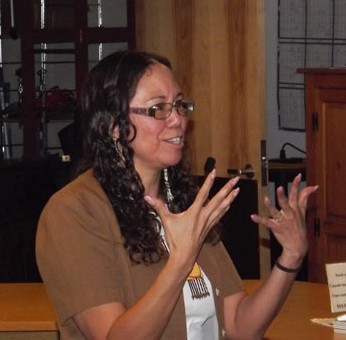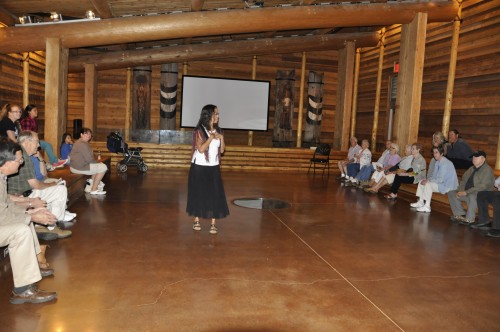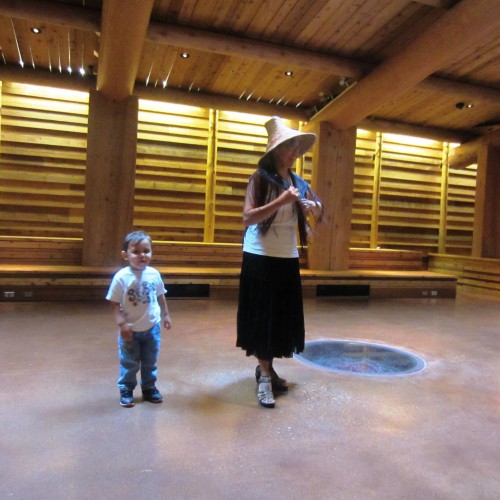Tulalip storyteller Lois Landgrebe discusses life as a storyteller
By Brandi N. Montreuil, Tulalip News
 TULALIP – Tulalip tribal member Lois Landgrebe has always been a storyteller. What started out as an entertaining way to comfort her younger sister during childhood has evolved into a beautiful craft she uses to connect people to her tribal culture.
TULALIP – Tulalip tribal member Lois Landgrebe has always been a storyteller. What started out as an entertaining way to comfort her younger sister during childhood has evolved into a beautiful craft she uses to connect people to her tribal culture.
Bilingual in English and her tribe’s traditional language, Lushootseed, she gracefully uses the two languages interchangeably to help the listener understand the historical importance of her stories, while also being entertained.
A steady increase of requests from across the region to hear native stories has catapulted this once local storyteller into a larger audience venue. Through the use of storytelling she is able to educate local communities about tribal history and culture, as well as teach listeners about ethics and morals in the same manner as her ancestors would have.
Tulalip News/See-Yaht-Sub recently sat down with Landgrebe to discuss the art of storytelling and how she uses the words of her elders to continue one of the oldest ways to communicate and pass on history for the next generation.
TN/SYS: When did you begin to tell stories?
Landgrebe: I started with my adoptive baby sister. Our mother passed away when I was 11 and she was 3, so we ended up sharing a bedroom together when we were relocated. She felt alone and scared, so I would go to bed early just to keep her company and ended up starting to tell her stories. I was about 12 or 13 years old when that started, and I learned through my birth mother Carol that her father was a storyteller. He had told stories to my mother and uncles when they were little, so she tells me storytelling is in my blood.
I used to tell stories to the elementary kids on my school bus route, and this was way out in the country boondocks and it takes almost an hour to get to school. I always had a saved seat among the elementary kids because I would carry on a saga of a story that would continue and continue and would last for weeks. They were unique stories that I made up about animals and they absolutely loved it. I would give each animal personality characteristics and they had conflicts and such, so it was like a movie.
TN/SYS: How did you come to tell Tulalip stories?
Landgrebe: I was hired as a Lushootseed language assistant in 1994 and I started learning traditional stories. This is where I also met Dr. Toby Langen and learned from Ray ‘Te At Mus’ Moses, Vi Hilbert and Grace Goedel. Each time I hear a story I am able to retain most of it. I can do Te At Mus’ stories word for word because I have heard them a dozen times; so I really try to keep to his format.
TN/SYS: What is it that you love the most about storytelling? You are naturally a calm, quiet person, but when you tell a story there is a transformation.
Landgrebe: I think most of the time I take kind of a back seat to things in life and such because I am a quiet person, but when it comes to storytelling and presentation, and even the state of the Tulalip Tribes, I take an absolute passion. Sharing that gives me the strength to take the front seat and get out there.
TN/SYS: What is your favorite story to tell?
Landgrebe: I think my favorite is the “Pheasant and Raven”. I like it because it has a repetition in it so I can pause and the audience can blurt out what comes next, because they know exactly what is going to happen because it happens to the other characters.
TN/SYS: Do you prepare yourself before you have to tell a story? Is there a routine that you do right before telling a story?
Landgrebe: Usually my mind is set and I have to give myself a few minutes. Sometimes I think it is the spirit of a storyteller that I take on because sometimes I don’t plan it. I just stand up and introduce or do a song, and it is like stories line up. It is hard to explain. Some that come right to me are in the back of my mind and I know that is the story that needs to be told.

Photo/ Brandi N. Montreuil, Tulalip News
TN/SYS: Do you write your stories down or is it all by memorization and how do you remember all those stories?
Landgrebe: A lot of it is by memorization. I do actually write them down upon request for an article or something.
Sometimes I catch myself in the wrong character. I will get done with “Mink and Whale” and start “Coyote and Rock,’and I will suddenly say whale instead of rock, so you have to be careful, especially in Lushootseed.
TN/SYS: When you tell the stories in Lushootseed do you feel it adds a deeper meaning to you and to your audience?
Landgrebe: Yes I do. I definitely do. I think that sometimes as Lushootseed speakers we take it for granted that we can write it down without thinking about it. And folks watch us write it down and they are amazed. I think that audiences that hear ancient Native languages, that when you first announce that this is endangered, and when you pronounce words that they have never ever heard or think would exist with the hard and guttural sounds, there are people that come up later and say they love to hear it. It is a way of preserving it.
TN/SYS: There are not many storytellers, and just like traditional carving, you have to be taught, you just can’t get up and tell a story. How do you feel as a Tulalip storyteller and Tulalip tribal member to be able to travel to different places with the teachings of your elders and from the people that taught you their stories?
Landgrebe: I feel like an echo of my ancestors. I really adhere to protocol to make sure that they are acknowledged. If the story is from Te At Mus and the Moses family I always make sure, as tribal members, they are mentioned. I always make sure there is that acknowledgement.
It makes me feel nostalgic. Not to toot my own horn because I feel humbled, but when I get on the stage, I feel important to be able to tell these stories. Stories are kept alive. When you are telling them you are breathing new life into them and it keeps that story going. And when you are listening to it, you continue to bring life to it as well, because it can’t move on without going into your ears and mind and being remembered. When I am telling them to little kids, I always pause for a moment and tell them about respect. We have to respect our traditional stories. We don’t know how old these stories are and how long they have been passed on from storyteller to children to another storyteller, so that makes children really stop and listen.
TN/SYS: When did you know that you were ready to step out and tell these traditional stories and that this was your path?
Landgrebe: I think it was right after I started working at the Hibulb Cultural Center. I started to become more known for storytelling with audiences that would visit. I knew I was a storyteller between 2001 and 2010, when I was with the Lushootseed program. They would receive requests to story tell and they would turn them over to me. To me, storytelling isn’t something that gives me anxiety, I feel privileged to be able to tell them.
TN/SYS: Do you consider storytelling an art form?
Landgrebe: Yes definitely. Most would look at it as more of an entertainment, which it was and is a form of entertainment. But there is also, locked in, an obligation to share a, or several, traditional teachings within it. It is almost like keeping in with a design, you can’t necessarily change it too much; you might be able to a little, only to fit to an audience. I have a way of clueing in to what my audience is. If they are younger children I can voice to them. If it was high school students I wouldn’t go, “ok and then they…” I just have that feel and I think as a storyteller you really know your audience and where their level of understanding is, so you can raise that level of complexity based on that.
TN/SYS: Storytelling is a very traditional form of communication, where do you see it fitting into the lives of our youth today, where mostly you compete with them checking Instagram and Facebook?
Landgrebe: That is a hard one. Our lives are very instamatic. Pulling away from technology can sometimes be a treat. Silencing the devices and being in a moment that is not a part of electricity or technology can give a whole another human interaction. Storytelling can be as enriching as watching a movie. You engage with your mind and your ears, and even your heart. When you listen you visualize the words. I have had groups, that when it is over, they are not ready for it to end.
TN/SYS: Can you tell me the elements of storytelling or the process you go through when you are learning a new story?
Landgrebe: I think the best way for me is to just hear it. I grasp onto stories better when I hear it told. I have learned stories on paper or on the Internet, but it takes me a little bit more time to learn them. I think the oral presentation is more susceptible for me to pick up. Sometimes scribbling down an outline because you are not quite as familiar with it as much, but as a storyteller you grasp onto the patterns of the story. A lot of our traditional stories have a pattern, we call them pattern episodes. The same thing will happen more than once in the story to different characters. It helps listeners learn the teaching.
My MO is patterns episode. When I stand up to tell the story it comes out stronger when it is in a pattern than if it wasn’t. Sometimes a story will just come out that way.
TN/SYS: Can you explain what you experience when you are telling a story?
Landgrebe: It is almost like an adrenaline and heaviness on your heart, but your heart is pumping through it. It is hard to explain. You are happy. You pause and you look for a lot of eye contact. It is really unique to see that connection and you pan across and you look to make sure your audience is with you. If you notice they are not then there is something you are not getting across to them.
It is amazing how everything melts away except for yourself and the audience. Afterwards you notice the stage and everything; you want to get off and get away. It is amazing how it all just shrinks away.
TN/SYS: What is your favorite age group to tell stories to?
Landgrebe: Third, fourth and fifth grade. They are old enough to understand the complexities of the story and not too old to think they know it all. Grown ups are a good group to but I really enjoy the youth.
Landgrebe is scheduled to appear on August 30 at 1:30 p.m. at the Hibulb Cultural Center for their monthly storytelling series. For more information on future storytelling events featuring Landgrebe or to request a story, please contact her at moontalk.storyteller@yahoo.com
Brandi N. Montreuil: 360-913-5402; bmontreuil@tulalipnews.com
